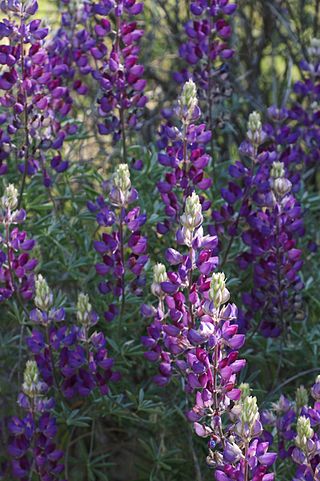Top Qs
Timeline
Chat
Perspective
Lupinus albifrons
Species of legume From Wikipedia, the free encyclopedia
Remove ads
Lupinus albifrons, silver lupine, white-leaf bush lupine, or evergreen lupine, is a species of lupine (lupin). It is native to California and Oregon, where it grows along the coast and in dry and open meadows, prairies and forest clearings. It is a member of several plant communities, including coastal sage scrub, chaparral, northern coastal scrub, foothill woodland, and yellow pine forest.
Remove ads
Description
Lupinus albifrons is a perennial shrub, taking up about 2 ft (0.61 m) of space and reaching 5 ft (1.5 m). It has a light blue to violet flower on 3–12 inches (7.6–30.5 cm) stalks. The leaves are silver with a feathery texture.[3] It grows in sandy to rocky places below 5,000 feet (1,500 m).[4]
Cultivation
This plant grows as a wildflower in the hills and valleys of California. It requires good drainage and needs little water once the roots are established.
Toxicity to livestock
The plant is deer-resistant due to the presence of the bitter-tasting alkaloid toxins anagyrine and lupinine.[5] Because of these toxins lupines can negatively affect livestock, causing birth defects and decreasing weight especially in young, inexperienced cattle.[5] When cows are under stress from lactating, especially in times of low forage availability, they will consume more lupine than usual.[5]
Mission blue butterfly
The federally endangered mission blue butterfly requires either Lupinus albifrons, Lupinus formosus and Lupinus variicolor, on which their larvae feed.[6] The butterfly becomes toxic itself when it feeds on the plant, leaving it with a bitter taste to deter predators.
Due to its potential danger to livestock, this lupine is removed from rangeland when possible, eliminating a crucial food plant from the butterfly's range[citation needed].
Remove ads
Infraspecific taxa
Lupinus albifrons has six different varieties, four of which occur only in California, the other two occur in both California and Oregon:[7]
- Lupinus albifrons var. albifrons, silver lupine
- Lupinus albifrons var. collinus, silver lupine
- Lupinus albifrons var. douglasii, Douglas' silver lupine
- Lupinus albifrons var. eminens, silver lupine
- Lupinus albifrons var. flumineus, silver lupine.
- Lupinus albifrons var. hallii, syn. Lupinus paynei, Payne's bush lupine. [8]
Remove ads
Photos
See also
References
External links
Wikiwand - on
Seamless Wikipedia browsing. On steroids.
Remove ads




